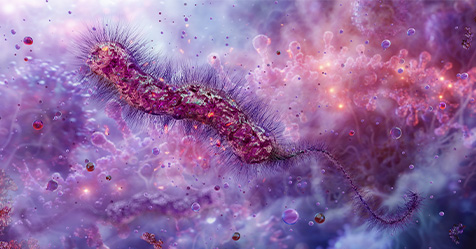The Legionella bacterium Legionella pneumophila (L. pneumophila), the fundamental agent of Legionnaires’ disease, is a water-based organism that causes infection when inhaled in an aerosol form.
Legionnaires’ disease acquired its name in 1976 when an outbreak of pneumonia occurred among persons attending a convention of the American Legion in Philadelphia.
Later, the bacterium causing the illness was named Legionella.
Normally associated with cooling towers and evaporative condensers, mist machines, humidifiers, whirlpool spas and showers, the L. pneumophila bacteria is most commonly associated with the disease outbreak legionellosis.
Legionella bacteria thrive in stagnant water — things such as water tanks, reservoirs, piping systems, sink basins, etc.
The bacteria require temperatures between 68 degrees Fahrenheit (F) and 113 degrees F — under 68 degrees Fahrenheit or over 140 degrees Fahrenheit and they are killed — and a supply of nutrients found in algae, rust, sludge and scale.
Preventing Proliferation
Health agencies continually draw attention to the risks of L. pneumophila and good practices concerning its prevention.
Conditions that affect the proliferation of Legionella in commercial facilities include:
- The presence of scale deposits or algae growth in the water
- Dead legs in pipework or stagnation due to low use of outlets and fixtures
- Low temperatures in hot water heaters and distribution systems
- Stratification in water heaters
- Inappropriate water treatment.
L. pneumophila may be able to colonize certain types of water fittings, pipework and materials used in the construction of water systems.
The presence of such materials and large quantities of sediment may provide nutrients for Legionella and can make eradication difficult.
In practice, L. pneumophila is found in many recirculating hot and cold water systems, particularly those found in hospitals, hotels, office complexes and factories.
Managing the risks from Legionella in water systems requires a holistic approach and a suite of control measures underpinned by a suitable and sufficient risk assessment specific to the risk system in question.
In hard water areas, scale formation can be a problem unless properly managed and can increase the likelihood of Legionella persisting.
Scale And Biofilms
Scale or lime scale is a hard, rock-like deposit of calcium or magnesium salts that forms in heat exchangers and cooling tower packing and other water-fed equipment as a result of heat.
Scale formation impairs heat transfer, interferes with flow and can be a breeding ground for Legionella bacteria.
The scaling tendency of a water supply will depend on the hardness of the water; but, if not adequately treated, even relatively soft water can fall victim to scaling when concentrated by evaporation.
Poor control not only puts your infrastructure at risk, but can also squander thousands of dollars in wasted energy, chemicals and water charges.
Scale is a major problem in both hot and cold water systems.
Dripping taps can deposit scale in and around the tap and, with high ambient room temperatures, provide an ideal growth medium for L. pneumophila.
In hot systems, scale can trap Legionella and biofilms, providing a perfect growth medium that disinfectants cannot penetrate.
Scale deposits colonized by Legionella can continuously re-contaminate a system, even after disinfection.
Trapped biofilms are a source of nutrients for L. pneumophila, and the products of their metabolism can lead to taste and odor problems.
Scale is a major cause of inefficiency in hot water systems.
Scale on heat exchange surfaces dramatically reduces the heat transfer efficiency and promotes corrosion in the pipework.
Descaling of a hot water system is time-consuming and expensive, making prevention very attractive.
Water softeners can reduce scale, but there is growing concern over the increase to sometimes-high levels of sodium in the water.
Recirculating Systems
Many air conditioning and refrigeration plant systems are water-cooled.
The heat generated by cooling coils is removed by water, which is passed through a water-cooling tower.
These are recirculating systems that operate at temperatures ideal for bacterial and algal growth.
They have been highlighted as a major possible source of Legionnaires’ disease mainly because of the large number of people that can be affected.
However, in a tower that is well-designed and maintained, the chances of problems related to L. pneumophila are greatly reduced.
Most cases of outbreaks have occurred in towers that were poorly designed and had little or no regular maintenance performed.
In cooling towers, temperature, water hardness, pH, scale and corrosion are all factors that increase the chance of biofilms, algae and Legionella colonization.
Many agents are used to control these factors, including scale and corrosion inhibitors, dispersants and biocides.
Water softeners are sometimes used, but they can cause a problem with foaming.
Biofilms are a major problem in cooling towers because, when combined with scale, they can reduce the efficiency of cooling systems to the point where the system no longer functions with regard to heat transfer.
Many safety officer and plant managers recommend the periodic chlorination and descaling of cooling towers.
However, chlorine is not always compatible with other treatment chemicals like corrosion inhibitors, is not effective in alkaline water and can cause corrosion.
Some biocides are effective against L. pneumophila if used in sufficient concentration.
But, some strains of L. pneumophila and other bacteria may become resistant to particular biocides.
Because of this, dual or alternating biocides are often used.
Electronic Treatment
What is required in all systems, either cold or hot, is a method of continuously controlling scale buildup and a water treatment regime that prevents the growth of biofilms, bacteria and, in particular, L. pneumophila.
An all-encompassing method is now available in the form of electronic scale treatment of water to prevent scale deposition together with the chlorination of all water supplied to a building or factory.
This involves the fitting of electronic water descaling equipment at strategic points in the water system.
Water treated by such systems will prevent scale from forming in pipework and on heat transfer surfaces and will, over a period of time, remove existing scale deposits.
There are many advantages to this non-intrusive engineering solution, including:
- A reduction in energy usage due to heat exchange surfaces remaining free of scale deposits
- Elimination of corrosion caused by scale deposits
- Elimination of downtime and labor costs involved in descaling systems
- Removal of a source of colonization by biofilms and L. pneumophila
- Increased water distribution efficiency and pressure by the removal of scale deposits that can reduce pipe diameters considerably.


